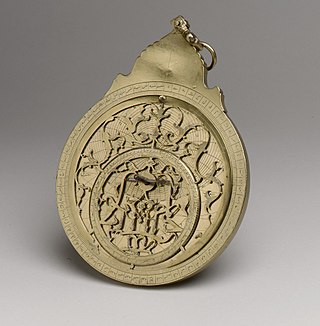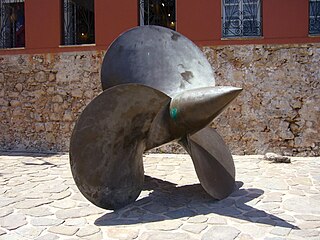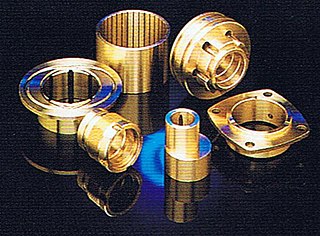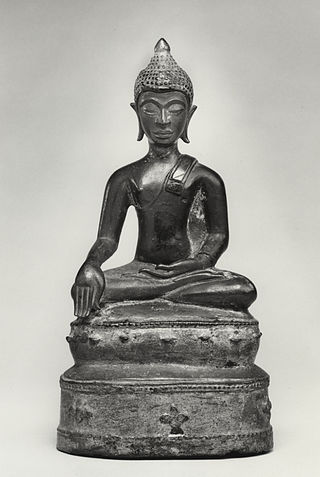Related Research Articles

An alloy is a mixture of chemical elements of which at least one is a metal. Unlike chemical compounds with metallic bases, an alloy will retain all the properties of a metal in the resulting material, such as electrical conductivity, ductility, opacity, and luster, but may have properties that differ from those of the pure metals, such as increased strength or hardness. In some cases, an alloy may reduce the overall cost of the material while preserving important properties. In other cases, the mixture imparts synergistic properties to the constituent metal elements such as corrosion resistance or mechanical strength.

Brass is an alloy of copper (Cu) and zinc (Zn), in proportions which can be varied to achieve different colours and mechanical, electrical, acoustic, and chemical properties, but copper typically has the larger proportion. In use since prehistoric times, it is a substitutional alloy: atoms of the two constituents may replace each other within the same crystal structure.

Bronze is an alloy consisting primarily of copper, commonly with about 12–12.5% tin and often with the addition of other metals and sometimes non-metals, such as phosphorus, or metalloids such as arsenic or silicon. These additions produce a range of alloys that may be harder than copper alone, or have other useful properties, such as strength, ductility, or machinability.

Metallurgy is a domain of materials science and engineering that studies the physical and chemical behavior of metallic elements, their inter-metallic compounds, and their mixtures, which are known as alloys.

Cupronickel or copper–nickel (CuNi) is an alloy of copper with nickel, usually along with small quantities of other elements added for strength, such as iron and manganese. The copper content typically varies from 60 to 90 percent.

Metalworking is the process of shaping and reshaping metals in order to create useful objects, parts, assemblies, and large scale structures. As a term, it covers a wide and diverse range of processes, skills, and tools for producing objects on every scale: from huge ships, buildings, and bridges, down to precise engine parts and delicate jewelry.

Brazing is a metal-joining process in which two or more metal items are joined by melting and flowing a filler metal into the joint, with the filler metal having a lower melting point than the adjoining metal.

An ingot is a piece of relatively pure material, usually metal, that is cast into a shape suitable for further processing. In steelmaking, it is the first step among semi-finished casting products. Ingots usually require a second procedure of shaping, such as cold/hot working, cutting, or milling to produce a useful final product. Non-metallic and semiconductor materials prepared in bulk form may also be referred to as ingots, particularly when cast by mold based methods. Precious metal ingots can be used as currency, or as a currency reserve, as with gold bars.

Bronze is the most popular metal for cast metal sculptures; a cast bronze sculpture is often called simply "a bronze". It can be used for statues, singly or in groups, reliefs, and small statuettes and figurines, as well as bronze elements to be fitted to other objects such as furniture. It is often gilded to give gilt-bronze or ormolu.

Phosphor bronze is a member of the family of copper alloys. It is composed of copper that is alloyed with 0.5–11% of tin and 0.01–0.35% phosphorus, and may contain other elements to confer specific properties. The tin increases the corrosion resistance and strength of the alloy, while the phosphorus increases its wear resistance and stiffness.

Babbitt metal or bearing metal is any of several alloys used for the bearing surface in a plain bearing.

Gun metal, also known as red brass in the United States, is a type of bronze – an alloy of copper, tin, and zinc. Proportions vary but 88% copper, 8–10% tin, and 2–4% zinc is an approximation. Originally used chiefly for making guns, it has largely been replaced by steel for that purpose. Gunmetal casts and machines well, and is resistant to corrosion from steam and salt water. It is used to make steam and hydraulic castings, valves, gears, statues, and various small objects, such as buttons. It has a tensile strength of 221 megapascals (32,100 psi) to 310 megapascals (45,000 psi), a specific gravity of 8.7, a Brinell hardness of 65 to 74, and a melting point of around 1,000 degrees Celsius.

Panchaloha, also called Pañcadhātu, is a term for traditional five-metal alloys of sacred significance, used for making Hindu temple murti and jewelry.

Arsenical bronze is an alloy in which arsenic, as opposed to or in addition to tin or other constituent metals, is combined with copper to make bronze. The use of arsenic with copper, either as the secondary constituent or with another component such as tin, results in a stronger final product and better casting behavior.
Bismuth bronze or bismuth brass is a copper alloy which typically contains 1-3% bismuth by weight, although some alloys contain over 6% Bi. This bronze alloy is very corrosion-resistant, a property which makes it suitable for use in environments such as the ocean. Bismuth bronzes and brasses are more malleable, thermally conductive, and polish better than regular brasses. The most common industrial application of these metals are as bearings, however the material has been in use since the late nineteenth century as kitchenware and mirrors. Bismuth bronze was also found in ceremonial Inca knives at Machu Picchu. Recently, pressure for the substitution of hazardous metals has increased and with it bismuth bronze is being marketed as a green alternative to leaded bronze bearings and bushings.
C41100 Lubaloy is a wrought copper alloy that is composed mainly of copper and zinc. Lubaloy possesses many favorable characteristics making it, and other types of brass, a popular choice in manufacturing. It is a source material in many processes including the creation of electrical components and bullet-making. There are both positive and negative health effects that are associated with the use of this material.

The conservation and restoration of copper and copper-alloy objects is the preservation and protection of objects of historical and personal value made from copper or copper alloy. When applied to items of cultural heritage, this activity is generally undertaken by a conservator-restorer.

Diehl Metall is a corporate division of the Diehl Stiftung & Co. KG, a worldwide operating industrial group with its head office in Röthenbach an der Pegnitz near Nuremberg, Germany. The production units of Diehl Metall are situated at 13 locations in Europe, Asia, South America and the US. With 3,420 employees the company generated a turnover of €917 million in 2017. Diehl Metall produces semi-finished products, forgings and rolled products, high-precision stamped parts with plating technologies as well as Schempp+Decker press-fit zones and metal-plastic compound systems. The company provides material development and production, sheet metal forming and forging technology as well as plating, press-fit, overmolding and assembling technology completely in-house.
References
Notes
- 1 2 3 4 Welter (2014)
- ↑ Aalco, pp.72-3
- ↑ Robert Hult, "Leaded Copper Alloys Get A New Lease on Life", ConnectorSupplier.com. (retrieved 16 October 2019)
- 1 2 Aalco, p.74.
- ↑ Richard Stone; Introduction to Internal Combustion Engines, 4th Edition, Palgrave Macmillan, 2012. ISBN 978-0-230-57663-6. Pages 160-1.
- ↑ Engine Bearing Materials catalogue, Glacier Vanderbell.
- ↑ "Copper Through the Ages" Archived 2021-11-10 at the Wayback Machine , Copper Development Association (retrieved 16 October 2019)
- ↑ Pare, Sascha (10 August 2022). "Researchers decode metal-making recipes in ancient Chinese text". The Guardian. Retrieved 10 August 2022.
Bibliography
- Aalco brochure, Pages 70-85.
- Jean-Marie Welter; Leaded Copper Alloys for Automotive Applications: A Scrutiny, European Copper Institute, 2014.